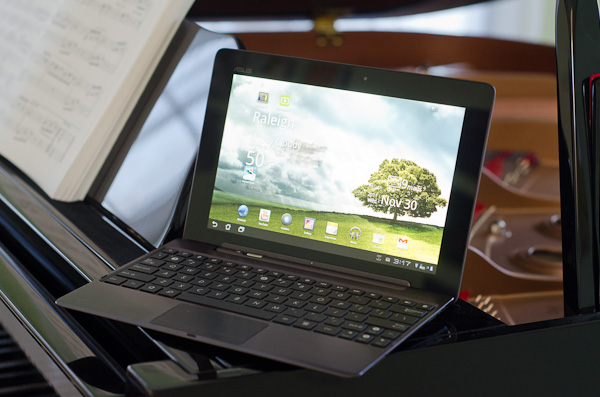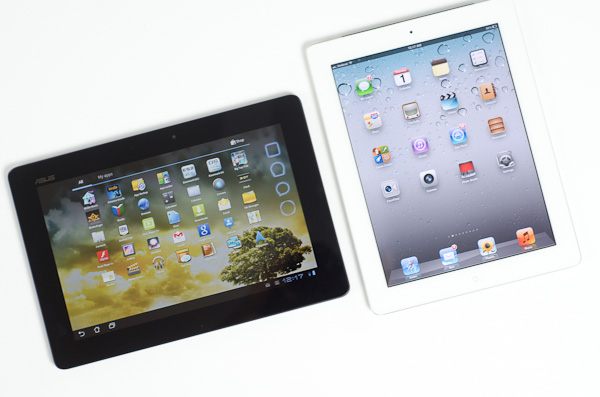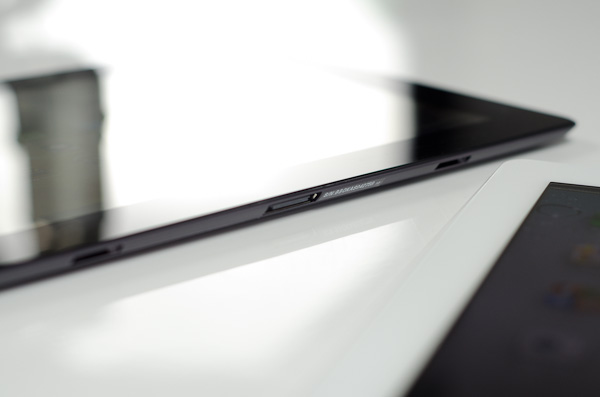ASUS Eee Pad Transformer Prime & NVIDIA Tegra 3 Review
by Anand Lal Shimpi on December 1, 2011 1:00 AM ESTGoing from making good motherboards to going head to head with Samsung for Google's affection is a pretty big step for ASUS, but it's one that the company has taken and done very well with. None of its peers have made the same transition, especially not while continuing to thrive in their existing businesses. I don't think anyone can say that ASUS' motherboards have suffered over the past several years as the company has transitioned, much like Apple, into the world of being a mobile computer manufacturer.
ASUS' first Android tablet was a knock out of the park. The original Eee Pad Transformer gave us a glimpse of the future with its keyboard dock while delivering a good Honeycomb experience for $100 less than the competition. As many sacrifices as ASUS had to make to reach its price point, the original Eee Pad remains one of the best Honeycomb tablets on the market. But the show must go on and simply being the cheapest on the block doesn't work anymore, particularly with companies like Amazon redefining what cheap means. It was time for a new flagship and today we have that tablet:
Priced at $499 the Eee Pad Transformer Prime will be available in North America during the week of 12/19.
| Tablet Specification Comparison | ||||||
| ASUS Eee Pad Transformer | ASUS Eee Pad Transformer Prime | Apple iPad 2 | Samsung Galaxy Tab 10.1 | |||
| Dimensions | 271mm x 175mm x 12.95mm | 263 x 180.8 x 8.3mm | 241.2 x 185.7 x 8.8mm | 256.6 x 172.9 x 8.6mm | ||
| Display | 10.1-inch 1280 x 800 | 10.1-inch 1280 x 800 Super IPS+ | 9.7-inch 1024 x 768 IPS | 10.1-inch 1280 x 800 PLS | ||
| Weight | 675g | 586g | 601g | 565g | ||
| Processor | 1GHz NVIDIA Tegra 2 (2 x Cortex A9) | 1.3GHz NVIDIA Tegra 3 (4 x Cortex A9) | 1GHz Apple A5 (2 x Cortex A9) | 1GHz NVIDIA Tegra 2 (2 x Cortex A9) | ||
| Memory | 1GB | 1GB | 512MB | 1GB | ||
| Storage | 16GB + microSD card | 32GB/64GB + microSD slot | 16GB | 16GB | ||
| Pricing | $399 | $499/$599 | $499 | $499 | ||
Whereas Motorola was first out of the gate with a Tegra 2 based Honeycomb tablet, ASUS is done with playing second fiddle. ASUS is NVIDIA's first and only launch partner for its new quad-core Tegra 3 SoC. The Google OS of choice is still Honeycomb, although I hear the Eee Pad Transformer Prime also happens to be Google's development and validation vehicle for Ice Cream Sandwich on Tegra 3.
The Prime is everything the original Eee Pad Transformer was missing. It's thinner than an iPad 2 or Galaxy Tab and built out of aluminum and glass. Other than minor details like the buttons and connectors, your hands never touch plastic when using the Transformer Prime. Even those plastic buttons look and feel great. The tablet is just beautiful. It echoes the design language of ASUS' Zenbook, but without the disappointment in the panel department. ASUS' latest tablet actually has the best display of any tablet we've reviewed, including those made by Apple and Samsung (more on this later).
The usual suspects are carefully placed around the perimeter of the Transformer Prime. Held in landscape mode the power/lock button is at the top left corner, with the volume rocker perpendicular to and just below it on the left side. Also along the left side is a micro HDMI output for display cloning and a microSD card slot. A standard 1/8" headset jack finds itself on the right side of the tablet, and ASUS' standard dock connector is bottom center. The original Eee Pad had two speaker grills, while the Prime has a single, larger speaker on the back of the device. Audio output is surprisingly full but the tablet doesn't get loud enough to overpower a noisy environment.
ASUS went a little crazy with the rubber stoppers all over the Prime. The dock connector and its two mechanical retention/secure points are plugged with these things, as is the USB port on the optional transformer dock.
Just like last time, the Eee Pad Transformer Prime can be mated to an optional keyboard dock for an extra $149. The dock adds a QWERTY keyboard, trackpad, an SD card reader, USB port and comes with its own 22Wh battery. The dock's battery not only powers itself but it can charge the Prime's battery, almost doubling battery life.
We'll spend the next several pages going through every detail of the new Eee Pad Transformer Prime as well as NVIDIA's Tegra 3 SoC, but on the surface, ASUS has built a formidable tablet. How does it fare under closer scrutiny? Very well it turns out...
A Lesson in How Not to Launch a Product
Of all of the things ASUS has learned from running the PC side of its business it seems that the proper way to launch a brand new platform didn't translate over to its tablet business. I received the Eee Pad Transformer Prime 39 hours ago and the NDA lifted just now. While this is not atypical for many mobile launches, ASUS should know better.
To do a thorough review of any product the minimum time we need to adequately integrate that product into our daily routine and come away with a deep understanding of the product is at least a week. I say that's the minimum amount of time because if you give us more, then we can do even better analysis and spend even more time bug hunting. Most of the players in the mobile space don't really get this, and as a result they are complicit in the disappointing amount of analysis that's done on their hardware. This will change as time goes on, but I honestly expected more from ASUS.
My WiFi is Broken
What's one of the biggest risks when you give reviewers only 39 hours to review a product? If something is wrong with the review sample, there's hardly any time to fix it. This time I drew the short straw and my Transformer Prime review sample arrived with highly questionable WiFi performance. Both range and performance were impacted by whatever plagued my sample. I got less range and much lower performance than the original Eee Pad Transformer regardless of location or wireless access point. How bad? My Prime had difficulty sustaining more than 2Mbps over WiFi. ASUS and NVIDIA both sent me proof that there wasn't something wrong with other samples, and from their data it looks like the WiFi stack in the Prime is at least comparable to the original Transformer. The problem may just be limited to my unit, although I tend to believe that if something goes wrong once, it's bound to go wrong more than once.
Based on the fact that wireless performance improves when docked and upstream speeds are almost normal, if I had to guess I'd say that the receive antenna is either not fully connected or somehow impaired from doing its normal duty. I should have a replacement unit in by tomorrow, but unfortunately that means you won't see any WiFi dependent results here.
ASUS chose Broadcom's BCM4329 for WiFi/Bluetooth duty. Although the controller supports both 2.4GHz and 5GHz operation, the Prime is limited to work on 2.4GHz networks. The rest of the design is pretty standard - you get a single spatial stream at a maximum of 72Mbps. Real world performance, if ASUS/NVIDIA's numbers are to be believed, should top out somewhere in the upper 30Mbps area.
Update: ASUS got us a fixed unit, be sure to check out our follow-up here.




















204 Comments
View All Comments
abcgum091 - Thursday, December 1, 2011 - link
After seeing the performance benchmarks, Its safe to say that the ipad 2 is an efficiency marvel. I don't believe I will be buying a tablet until windows 8 is out.ltcommanderdata - Thursday, December 1, 2011 - link
I'm guessing the browser and most other apps are not well optimized for quad cores. The question is will developers actually bother focusing on quad cores? Samsung is going with fast dual core A15 in it's next Exynos. The upcoming TI OMAP 4470 is a high clock speed dual core A9 and OMAP5 seem to be high clock speed dual core A15. If everyone else standardizes on fast dual cores, Tegra 3 and it's quad cores may well be a check box feature that doesn't see much use putting it at a disadvantage.Wiggy McShades - Thursday, December 1, 2011 - link
If the developer is writing something in java (most likely native code applications too) it would be more work for them to ensure they are at most using 2 threads instead of just creating as many threads as needed. The amount of threads a java application can create and use is not limited to the number of cores on the cpu. If you created 4 threads and there are 2 cores then the 4 threads will be split between the two cores. The 2 threads per core will take turns executing with the thread who has the highest priority getting more executing time than the other. All non real time operating systems are constantly pausing threads to let another run, that's how multitasking existed before we had dual core cpu's. The easiest way to write an application that takes advantage of multiple threads is to split up the application into pieces that can run independently of each other, the amount of pieces being dependent on the type of application it is. Essentially if a developer is going to write a threaded application the amount of threads he will use will be determined by what the application is meant to do rather than the cores he believes will be available. The question to ask is what kind of application could realistically use more than 2 threads and can that application be used on a tablet.Operaa - Monday, January 16, 2012 - link
Making responsive today UI most certainly requires you to use threads, so shouldn't be big problem. I'd say 2 threads per application is absolutely a minimum. For example, talking about browsing web, I would imagine useful to handle ui in one thread, loading page in one, loading pictures in third and running flash in fourth (or more), etc.UpSpin - Thursday, December 1, 2011 - link
ARM introduced big.LITTLE which only makes sense in Quad or more core systems.NVIDIA is the only company with a Quad core right now because they integrated this big.LITTLE idea already. Without such a companion core does a quad core consume too much power.
So I think Samsung released a A15 dual core because it's easier and they are able to release a A15 SoC earlier. They'll work on a Quad core or six or eight core, but then they have to use the big.LITTLE idea, which probably takes a few more months of testing.
And as we all know, time is money.
metafor - Thursday, December 1, 2011 - link
/bogglebig.Little can work with any configuration and works just as well. Even in quad-core, individual cores can be turned off. The companion core is there because even at the lowest throttled level, a full core will still produce a lot of leakage current. A core made with lower-leakage (but slower) transistors can solve this.
Also, big.Little involves using different CPU architectures. For example, an A15 along with an A7.
nVidia's solution is the first step, but it only uses A9's for all of the cores.
UpSpin - Friday, December 2, 2011 - link
I haven't said anything different. I just added that Samsung wants to be one of the first who release a A15 SoC. To speed things up they released a dual core only, because there the advantage of a companion core isn't that big and the leakage current is 'ok'. It just makes the dual core more expensive (additional transistors needed, without such a huge advantage)But if you want to build a quad core, you must, just as Nvidia did, add such a companion core, else the leakage current is too high. But integrating the big.LITTLE idea probably takes additional time, thus they wouldn't be the first who produced a A15 based SoC.
So to be one of the first, they chose to take the easiest design, a dual core A15. After a few months and additional time of RD they will release a quad core with big.LITTLE and probably a dual core and six core and eigth core with big.LITTLE, too.
hob196 - Friday, December 2, 2011 - link
You said:"ARM introduced big.LITTLE which only makes sense in Quad or more core systems"
big.LITTLE would apply to single core systems if the A7 and A15 pairing was considered one core.
UpSpin - Friday, December 2, 2011 - link
Power consumption wise it makes sense to pair an A7 with a single and dual core already.Cost wise it doesn't really make sense.
I really doubt that we will see some single core A15 SoC with a companion core. And dual core, maybe, but not at the beginning.
GnillGnoll - Friday, December 2, 2011 - link
It doesn't matter how many "big" cores there are, big.LITTLE is for those situations where turning on even a single "big" core is a relatively large power draw.A quad core with three cores power gated has no more leakage than a single core chip.